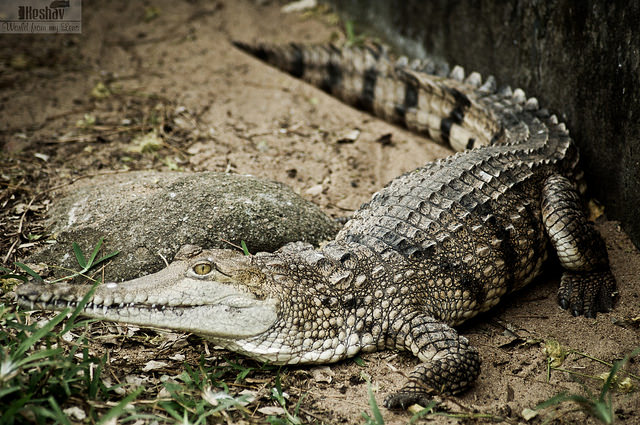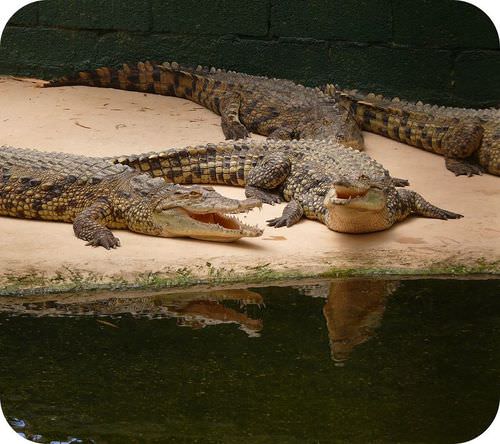10.13: Crocodilia
- Page ID
- 14165

Crocodile or Alligator?
This picture is a crocodile, identified by it's V-shaped snout. Alligators have more of a U-shaped snout. Although crocodiles and alligators have a few differences, they are very much alike and belong to the same order, Crocodilia.
Alligators and Crocodiles
Crocodilia, containing both alligators and crocodiles, is an order of large reptiles. Reptiles belonging to Crocodilia are the closest living relatives of birds. Reptiles and birds are the only known living descendants of the dinosaurs. Some would day that alligators and crocodiles actually look like small dinosaurs. Dinosaurs that evolved wings are the ancestors of birds.
The basic crocodilian body plan (Figure below) is a very successful one and has changed little over time. Modern species actually look very similar to their Cretaceous ancestors of 84 million years ago. All species of crocodilians have similar body structures, including an elongated snout, powerful jaws, muscular tail, large protective scales, streamlined body, and eyes and nostrils that are positioned on top of the head.

Characteristics of Crocodiles
Crocodilians have a flexible, semi-erect posture. They can walk either in a low, sprawled “belly walk,” or hold their legs more directly underneath them to perform the “high walk.” Most other reptiles can only walk in a sprawled position.
All crocodilians have, like humans, teeth set in bony sockets. But unlike mammals, they replace their teeth throughout life. Crocodiles and gharials (large crocodilians with longer jaws) have salivary glands on their tongue, which are used to remove salt from their bodies. This helps with life in a saltwater environment. Crocodilians are often seen lying with their mouths open, a behavior called gaping. One of its functions is probably to cool them down.
The crocodilian digestive system is highly adapted to their lifestyle. Crocodilians are known to swallow stones, known as gastroliths, which help digest their prey. The crocodilian stomach is divided into two chambers. The first is powerful and muscular. The other stomach is the most acidic digestive system of any animal. It can digest mostly everything from their prey, including bones, feathers, and horns!
All crocodilians are carnivores. They feed on live animals such as birds, small mammals and fish. Crocodilians use several methods of attack when pursuing live prey. One approach is that of the ambush. The crocodilian lies motionless beneath the water's surface with only their nostrils above the water line. This keeps them concealed while they watch for prey that approaches the water's edge. The crocodilian then lunges out of the water, taking their prey by surprise and dragging it from the shoreline into deep water where the prey is killed.
The sex of developing crocodilians is determined by the temperature of the eggs during incubation, when eggs are kept warm before they hatch. This means that the sex of crocodilians is not determined genetically. If the eggs are kept at a cold or a hot temperature, then their offspring may be all male or all female. To get both male and female offspring, the temperature must be kept within a narrow range.
Female crocodilians care for the young after they hatch, providing them with protection until they grow large enough to defend themselves. In many species of crocodilians, the female carries her tiny offspring in her mouth.
Evolving More Complex Structures
Like all reptiles, crocodilians have a relatively small brain, but the crocodilian brain is more advanced than those of other reptiles. Because of their aquatic habitat, the eyes, ears, and nostrils are all located on the same "face" in a line one after the other.
The crocodiles have advanced sensory organs. They see well during the day and may even have color vision, and they also have excellent night vision. A third transparent eyelid, the nictitating membrane, protects their eyes underwater. The eardrums are located behind the eyes and are covered by a movable flap of skin. This flap closes, along with the nostrils and eyes, when they dive. This prevents water from entering their external head openings. Their jaws are covered with sensory pits, which hold bundles of nerve fibers that respond to the slightest disturbance in surface water. Crocodiles can detect vibrations and small pressure changes in water. This makes it possible for them to sense prey and danger even in total darkness, and becomes very useful when the animal is submerged in the water.
Like mammals and birds, and unlike other reptiles, crocodiles have a four-chambered heart. But, unlike mammals, blood with and without oxygen can be mixed.
Summary
- Crocodilians swallow stones, known as gastroliths, which help digest their prey.
- The sex of developing crocodilians is determined by the temperature of the eggs during incubation.
- The crocodiles have advanced sensory organs, including keen eyesight, eardrums, and sensory pits that detect disturbances in the water.
Explore More
Use the resources below to answer the questions that follow.
Explore More I
- American Alligator at http://animals.nationalgeographic.com/animals/reptiles/american-alligator/
- Where do American alligators live?
- What do alligators eat?
- What conditions have led to the recovery of the American alligator?
Explore More II
- Bubble-Blowing Saltwater Crocodiles at http://www.youtube.com/watch?v=5OntFsIwGEw (1:53)
- In what kind of courting displays do saltwater crocodiles (Crocodylus porosus) engage?
- Do saltwater crocodiles have internal or external fertilization?
Explore More III
- Baby Siamese Crocodiles at http://www.youtube.com/watch?v=CUQMkS8Et2s (4:05)
- What kind of maternal care do crocodile mothers show their young? When does this care begin?
- What do baby crocodiles do as soon as they hatch?
- Why is it important for mother crocodiles to guard their nests?
Review
- Name four features that all crocodilians share.
- How is the sex of alligators and crocodiles determined?
- Describe digestion in crocodilians.
- Describe the special sensory organs of crocodiles.

